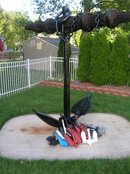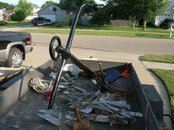Although I really like the idea of waterproofing some cheap canvas bags, the OP would probably need half a dozen of them, since he's diving in Salvage Heaven, lucky guy!
If he wants to just lift the weight of the rope, a far less costly alternative would be to use heavy-duty plastic grocery bags with the built-in handles, the kind that don't tear easily. The US Post Office has some bags that are even stronger, if you can get them from a friendly carrier. Either would provide excellent re-usable lift bags on a shoestring budget! That's my kind of budget, I might add....

Folded flat or rolled up, a dozen of them could be easily stowed or clipped to a D-ring. Another plus!
Cheap, light lift rope could be similarly stowed out of the way until needed.
Deployment would be as simple as tieing one end of the "lift" rope through the plastic "lift" bag handles, then tieing the other end to the salvage anchor or it's rope. Then, the bag could be partially inflated (to allow for expansion). To prevent spilling at the surface, I'd probably close the bag with some kind of tie or knot, and make a vent hole above the closure. Once released to mark the spot, the bags and salvage items could later be retrieved from a boat on the surface, if that's what the OP planned to do.
Although it might be less productive overall, my preference would be to eliminate the need for the boat by using flotation on the surface to suspend salvage items
at depth as they are collected on the dive.
A nice DIY float could be made from an inflated inner tube as some have mentioned.
Instead, I use a "tuna ball" mooring buoy on the surface to which my flag line and handle are attached, but that's not exactly a "make your own gear" solution.... My 1/4" Lexan line handle
is homemade though....

On a single dive, I've brought back several light anchors hanging from my flag line handle, with their rope coiled nicely out of the way. Once, I even brought back a new mountain bike suspended in similar fashion. No problem at all except for the stares from other divers!

Having the items suspended at depth from a surface float is a little easier to manage than suspended from a lift bag at depth, especially if the lift bag doesn't have a manual release valve. Wrangling an ascending bag to tip out some air is
not a lot fun!

All in all, the OP's idea to pick up the marked items later is probably pretty good, considering he'll be able to cover more ground than he would towing a bunch of suspended anchors!

Dave C







